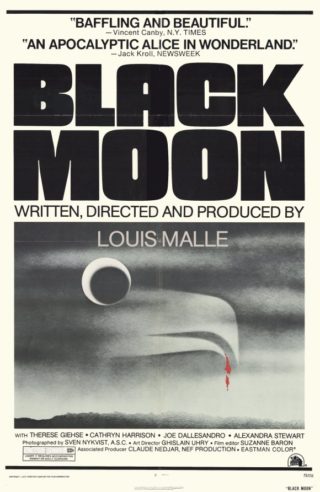 A dark, freaky headscratcher from a filmmaker beloved by art snobs the world over: the French Louis Malle, best known for refined fare like ATLANTIC CITY, MY DINNER WITH ANDRE and VANYA ON 42nd STREEET. BLACK MOON is an intriguing anomaly in Malle’s filmography, and a definite standout in the category of surreal, quasi-futuristic baloney.
A dark, freaky headscratcher from a filmmaker beloved by art snobs the world over: the French Louis Malle, best known for refined fare like ATLANTIC CITY, MY DINNER WITH ANDRE and VANYA ON 42nd STREEET. BLACK MOON is an intriguing anomaly in Malle’s filmography, and a definite standout in the category of surreal, quasi-futuristic baloney.
This film was actually part of a fairly popular seventies tradition, during which established European filmmakers turned to bizarre ALICE IN WONDERLAND-inspired flights of fancy—see Roman Polanski’s WHAT! (1972) and Claude Chabrol’s ALICE OR THE LAST ESCAPADE (1977), both of which have much in common with BLACK MOON.
In truth, Louis Malle (who died in 1995) always had a dark side. He was a close friend of the famed surrealist Luis Bunuel, and made a number of decidedly Bunuelian films during the sixties and seventies. These include THE FIRE WITHIN, a disturbing evocation of alcoholism and desperation; the semi-autobiographical MURMER OF THE HEART, which climaxes with its young hero having sex with his own mother; and 1975’s BLACK MOON, surely the strangest and most horrific of all Malle’s films.
Made shortly before Malle quit his native France for the more lucrative shores of Hollywood, BLACK MOON was shot in and around the filmmaker’s own country home. It contained a cast of counterculture icons that included British sexpot Kathryn Harrison and ex-Andy Warhol acolyte Joe Dallessandro, and featured script contributions by Luis Bunuel’s daughter-in-law Joyce. In the manner of many European productions of the time, the film was shot and released in English and French language versions (Malle always claimed he preferred the former), and died a quick death critically and financially. My recommendation? Track down a copy of BLACK MOON in place of MY DINNER WITH ANDRE.
Lily, a virginal young woman, drives through an unidentified rural countryside. Her troubles start when she runs over a skunk; she continues on, plowing through a roadblock set up by machinegun wielding, gas mask wearing women. The road eventually becomes impassable by car, so Lily is forced to continue on foot through an increasingly bizarre landscape in which flowers cry out when they’re stepped on, animals talk, naked children frolic and a unicorn is glimpsed.
Lily ends up in a chateau inhabited by an old woman who it seems can read Lily’s mind, at least when the coot’s not reciting details about Lily’s every action into a Dictaphone. The old woman also has a bunch of alarm clocks that all go off at once…shortly after which she unexpectedly drops dead.
Lily runs into the woman’s son outside the chateau; he’s a studly mute who shows absolutely no emotion upon learning of his mother’s passing. But then the old goat’s not really dead, which becomes evident when her seductive twentyish daughter revives her ma by sticking one of her breasts in her mouth!
Amid such insanity, Lily fortifies herself by looking for the unicorn she spotted earlier. After a lengthy search through the chateau’s grounds she finally tracks down the animal, only to have it telepathically berate her in a stern ladyish voice.
Lily heads back inside the chateau, where she plays a piano sonata for the old woman, her kids and the many naked children who suddenly pack the house–yet when Lily finishes playing she finds the place empty. But then the unicorn reappears. This time Lily figures out how to please the critter: by removing her blouse and offering herself to it!
It could be argued that the true auteur of BLACK MOON is not Louis Malle but cinematographer Sven Nykvist, a true master of the form who’s worked for filmmakers like Ingmar Bergman and Woody Allen. Nykvist’s gorgeously rendered imagery, bathed in seductive pastoral hues, is among his finest-ever work. The film has an appropriately hallucinatory ambiance that falls somewhere between fairly tale and nightmare, and Nykvist’s photography is a large part—indeed, perhaps the largest part—of the effect.
Not that Malle himself doesn’t deserve credit. His pacing is skilled, deliberate but never punishing, and he does a fine job relating his surreal narrative almost entirely through images, with very little dialogue to help things along.
This isn’t to say, however, that the film is a complete or even partial success. It’s silly and inconsequential (I’ve no idea what the Hell the title is supposed to mean), and ultimately feels experimental above all else. As we all know, experiments have an equal chance of success or failure, and BLACK MOON, unfortunately, pretty much falls into the latter category.
Vital Statistics
BLACK MOON
NEF/Bioskop Film
Director: Louis Malle
Producer: Claude Najar
Screenplay: Louis Malle, Ghislain Uhry, Joyce Bunuel
Cinematography: Sven Nykvist
Editing: Suzanne Baron
Cast: Cathryn Harrison, Therese Giehse, Joe Dallesandro, Alexandra Stewart
